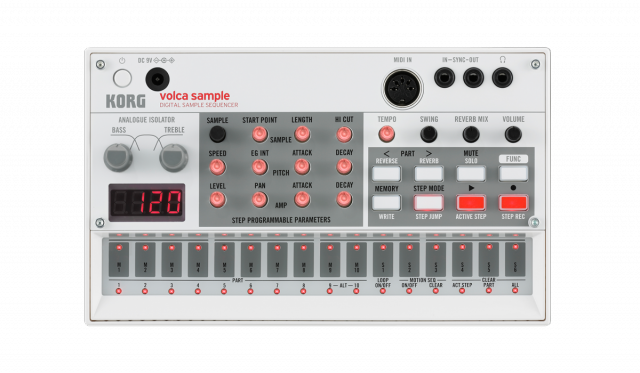The KORG volca sample is a fun-looking sample “sequencer” – it can play back, modify, and mangle pre-recorded samples in a step sequencer. But it requires a dedicated iOS app to do the actual sampling.
That makes for a mixed bag, straight out of the gate. As KORG says:
“The new volca lets you recapture the excitement of the first generation of samplers, in which any sound — vocals, spoken words, ambient sound, or glitches — becomes material for your creations!”
— right, but then it leaves out one of the best things about those hardware samplers, namely – sampling.
With that disappointment out of the way, the volca sample otherwise is full of some cool ideas. Let’s have a look at what it can do.
The heart of the beast is the sound parameters, which you can then map to individual steps:
Sample select, start point, length, hi cut
Pitch: speed, envelope, attack, decay
Amplitude: level, pan, attack, decay
And you can motion-sequence each of these.
There’s also per-sample reverse and reverb, plus overall reverb mix and swing.
The “Analog Isolator” gives you bass and treble controls. (UK-style, that’s “Analogue Isolator” on the front panel.)
Specs:
31.25kHZ, 16-bit sampling
4MB of sample size (65 seconds) – not bad
100 user sample slots
8-note polyphony
10 parts, 16 patterns, chain able into 16-pattern sequences and 6 songs
The hardware isn’t deficient as far as sync and I/O, at least. You get MIDI input for triggering samples and even parameter changes (that gets interesting), as well as the requisite MIDI sync. There’s also the usual sync in for connecting to other KORG units. And like the other volcas, it’s battery powered.
The big design tradeoff is really this iOS app. Now, of course, there are some advantages to this approach. It means that you can use your mobile device to gather sounds on the go, and manage those samples. And I have no doubt that means better sample management than you’d get just plugging into the device.
It’s just a shame that this can’t sample a live audio input, though, as that takes some of the fun and spontaneity out of using hardware for samples. And the competition from KORG in today’s announcements is tough, too. If you’re going to have to use an app, KORG’s Gadget app is compelling on its own, without the addition of additional hardware.
We’ll just have to get our hands on the volca sample to see what the experience is like using this mobile app, what it can do, and how the two interoperate. I have no details of that yet – not even a screenshot – so it occurs that if they’ve really nailed the app, they might convince us that this is the way to go.
And meanwhile, MIDI control of parameters and all the sequencing stuff looks fun.
In fact, if anything, the big challenge is that volca sample has some big reputations to live up to. The volca beats’ massive bass drum is becoming indispensable in the studio, and the volca keys, perhaps the most unsung of the original trio, is one of my favorite synths of the past couple of years.
But I look forward to trying out the newest entry.
More on the KORG site:
volca sample [KORG USA]
By the way, if you are going to have to use external hardware to sample, I’d have a look at the boutique microGranny 2. This wonderful gadget does its own sample mangling (granular style), but reads from an SD card. And you can be the only person on your block to own one, which probably won’t be true of something from KORG.

